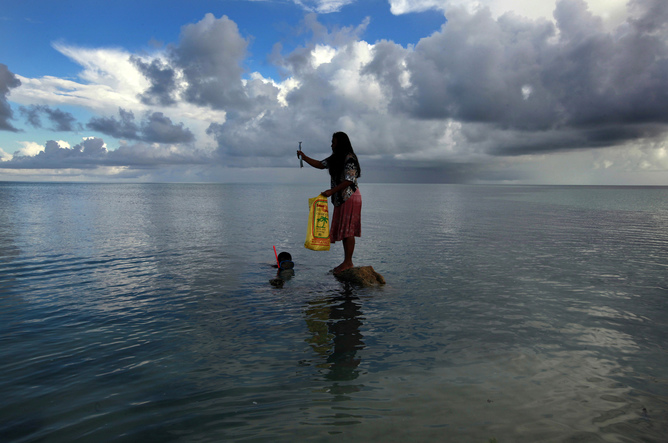Migration, Displacement and Human Mobility and Our Future

Please note that we are not authorised to provide any investment advice. The content on this page is for information purposes only.
One possible future – a glimpse of our children’s fate if the climate keeps changing faster than our efforts to address it. Submerged countries. Abandoned cities. Fields that no longer grow. Political disruptions that trigger new conflict, and even more floods of desperate peoples seeking the sanctuary of nations not their own.
One possible future – a glimpse of our children’s fate if the climate keeps changing faster than our efforts to address it. Submerged countries. Abandoned cities. Fields that no longer grow. Political disruptions that trigger new conflict, and even more floods of desperate peoples seeking the sanctuary of nations not their own.
The words above were not found in an ActionAid or Oxfam briefing at the Paris climate talks. They come from US president Barack Obama’s address to the conference on its opening day last Monday, as he described one possible future under climate change.
These images could become reality if there are insufficient reductions in carbon emissions. There are very real limits to adaptation that will be surpassed. In the language of the negotiations, these types of impacts are called “loss and damage”.
What is loss and damage?
Many observers equate loss and damage to liability and compensation. However, in fact, the current loss and damage agenda has little to do with determining monetary compensation.
Prominent elements instead include issues of migration, displacement and human mobility. A key demand of the developing countries’ group – the G77 and China – is to establish a climate change displacement facility in the Paris agreement, which could coordinate work on climate change displacement, including assisting in developing arrangements for emergency relief and assisting in providing for organised migration and planned relocation.
The loss and damage agenda also includes addressing “slow onset events”: sea level rise, rising temperatures, ocean acidification, glacial retreat, salinisation, land and forest degradation, loss of biodiversity and desertification.
Sea level rise threatens the very existence of Kiribati. David Gray/Reuters
Red lines
In 2013, the UNFCCC – the UN body that organises the annual climate conference – created the Warsaw International Mechanism for loss and damage associated with climate change impacts, with a mandate that will need to be periodically reviewed.
Now in the context of the Paris negotiations, there is substantial desire on the part of the G77 and China to both expand the mandate of the current mechanism and give it a more permanent status. Inclusion of loss and damage is a firm red line for many developing countries, in particular the small island states and least developed countries. They have clearly stated that there will not be an agreement in Paris if the final text does not include a relevant provision.
On the other side of the issue, members of the Umbrella Group (the United States and allies such as Australia, Canada and Norway) and the European Union have been opposed to the inclusion of loss and damage in the agreement.
The strong red lines on both sides of the issue have led to loss and damage being one of a small number of difficult issues set aside to be resolved in the final week of the conference. Other issues of such prominence include finance, differentiation (who has to do what), ambition (setting a long-term temperature goal), and response measures (what to do when measures to address climate change hurt fossil fuel-dependent economies).
It is around this small number of highly charged issues that the package of the final deal is likely to be constructed – comprising the political trade-offs that will make it possible, or not, to conclude negotiations here successfully.
Room for movement
Developed countries’ determination seemed very firm before the Paris meeting. The United States in particular had been very clear that it did not want a separate provision for loss and damage in the agreement.
Recently, there have been indications that developed countries might be softening their stance. It is not particularly surprising that they might want to avoid the public relations and diplomatic problems associated with complete opposition to a major demand of small island states and least developed countries.
US special envoy for climate change, Todd Stern, told a press conference at the summit: “From the president on down, the US is quite focused on this issue and I think that we’ll land it.” However, Stern also stressed, “We won’t accept the notion that there should be liability and compensation for loss and damage, that’s a line that we can’t cross.”
For at least the past few months, rumours have been circulating that the United States could live with the inclusion of loss and damage in the agreement, if there were a clause included that specifically excluded liability and compensation – that loss and damage was about everything but compensation for impacts of climate change.
That’s an interesting approach. Certainly many countries have been strongly suggesting that loss and damage is about much more than compensation – the migration and slow onset agendas are really quite important. However, it is also a potentially dangerous approach, with a threat that specific reference under the climate regime excluding compensation for climate impacts may have repercussions in other arenas such as the International Court of Justice.
So now in the final stretch towards an agreement, as surprising as it seems, it appears that all parties would like to see loss and damage included in the agreement – from the United States to the small island states and least developed countries. The devil, as always, is in the details.
Rich and poor countries face off over ‘loss and damage’ caused by climate change is republished with permission from The Conversation






